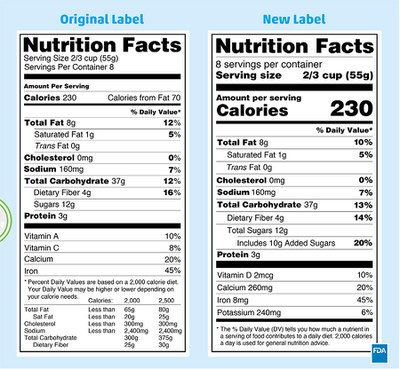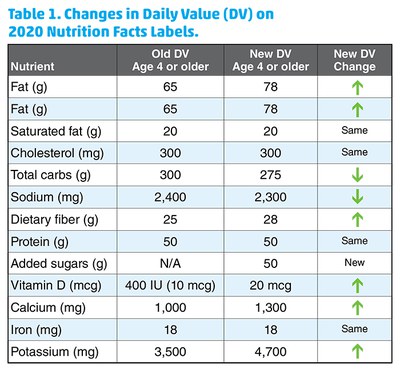Questions and Answers About the Updated Nutrition Facts Label (FN1994, Oct. 2020)

- iStock.com
We have been seeing the Nutrition Facts label printed on most food products since 1994. With advances in nutrition research, we have new recommendations.
In 2016, the Food and Drug Administration updated its rules for nutrition labeling on packaged foods. Large manufacturers (more than $10 million in sales) were required to switch to the new label by 2020. Smaller food manufacturers were allowed until 2021 to comply. Some small businesses are exempt from nutrition labeling.
This handout identifies key changes in the Nutrition Facts label. The goal of Nutrition Facts labels is to allow consumers to make informed decisions about the food they buy.
Q: What is the history of nutrition labeling on foods?
Before the 1960s, little if any nutrition information was present on food packages. Between the mid-1940s and 1960s, the food was considered “for special dietary uses” if calories or sodium values were listed.
More processed food (mixes, etc.) appeared in grocery store shelves in the 1960s. As nutrition researchers linked diet with various diseases, a need for informing consumers emerged. By 1973, many food packages showed calories, protein, carbohydrate, fat and percent of the daily recommendation for vitamins A, C, thiamin, riboflavin, niacin, and the minerals calcium and iron.
Two key reports regarding diet and health appeared in the late 1980s. In response, the Nutrition Labeling and Education Act of 1990 was passed and covered foods overseen by the Food and Drug Administration. By 1994, consumers began seeing Nutrition Facts labels on most foods.
Q: Did any changes occur on the 1994 Nutrition Facts labels before 2020?
“Trans fat” was added to nutrition labels in 2006. Trans fats are created in an industrial process that adds hydrogen to liquid vegetable oils to make them more solid at room temperature. Trans fats may raise your bad (LDL) cholesterol levels and lower your good (HDL) cholesterol levels. Increased cholesterol buildup, or plaque, increases your risk of developing heart disease.
Q: What are the key changes to the Nutrition Facts label?
The number of calories per serving is the largest item on the label. Calories from fat is not on the label. You will note that serving size is in a larger, bolder font to attract your attention. Serving sizes were updated to be more realistic to what people actually eat. For example, a serving of cereal is now 1 cup, where it used to be ¾ cup.
Calcium and iron values remain on labels, but vitamins A and C are not required on Nutrition Facts labels. Most people meet the daily recommendations for these vitamins. Potassium and Vitamin D now appear on most labels (unless the package qualifies for simplified labeling).
“Added sugar” now is required on labels. Added sugars are sugars not present naturally in the food.
“Total Sugars” includes natural sugars such as lactose in milk plus added sugar such as corn syrup.
Although the example labels are for the same food, you will note that the Percent Daily Value (%DV) differs in some cases. The %Daily Value (DV) shows how a serving of the food contributes to your daily diet. As shown in Table 1, some daily values were updated to reflect current nutrition research.

For more information about nutrition labeling, see www.fda.gov.
See www.ag.ndsu.edu/food for more information about nutrition and health.

Test Your Knowledge
According to the new Nutrition Facts label example above,
a. what is the % Daily Value (DV) for vitamin D? _________%
b. what is the % DV for potassium? _________%
c. what is the % DV for total carbohydrate? _______%
d. Which label shows added sugars? ________________________
e. How much added sugar is present? _______ grams
Answers: a. 10; b. 6; c. 13; d. New; e. 10
NDSU Extension does not endorse commercial products or companies even though reference may be made to tradenames, trademarks or service names. NDSU encourages you to use and share this content, but please do so under the conditions of our Creative Commons license. You may copy, distribute, transmit and adapt this work as long as you give full attribution, don’t use the work for commercial purposes and share your resulting work similarly. For more information, visit www.ag.ndsu.edu/agcomm/creative-commons.
County commissions, North Dakota State University and U.S. Department of Agriculture cooperating. NDSU does not discriminate in its programs and activities on the basis of age, color, gender expression/identity, genetic information, marital status, national origin, participation in lawful off-campus activity, physical or mental disability, pregnancy, public assistance status, race, religion, sex, sexual orientation, spousal relationship to current employee, or veteran status, as applicable. Direct inquiries to Vice Provost for Title IX/ADA Coordinator, Old Main 201, NDSU Main Campus, 701-231-7708, ndsu.eoaa@ndsu.edu. This publication will be made available in alternative formats for people with disabilities upon request, 701-231-7881.


